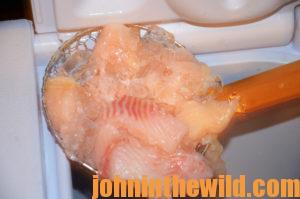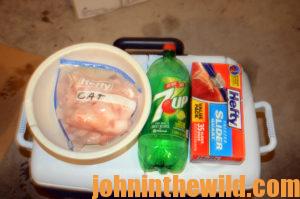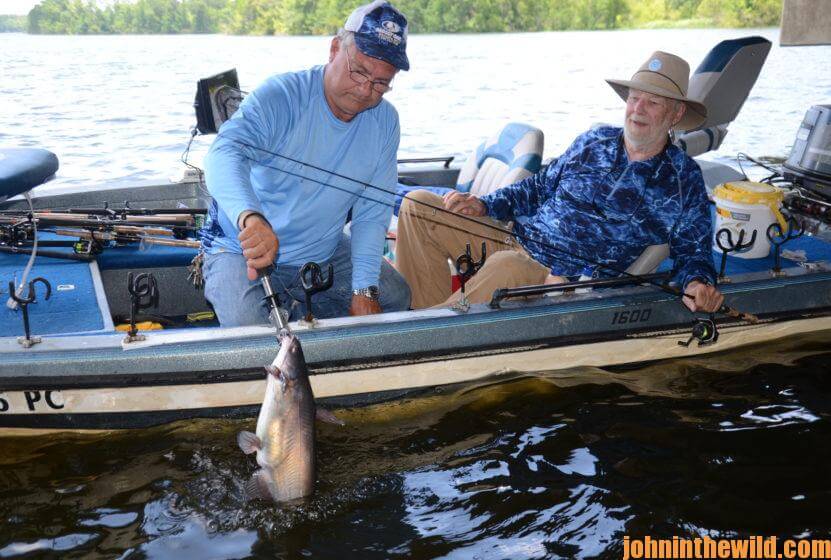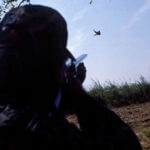Editor’s Note: Catfish are hard-fighting and delicious to eat. The equipment you need to catch cats is inexpensive and easy to find, and the ways you can catch catfish successfully are numerous. The largest catfish on record is a 9-foot long, 646-pound Mekong giant catfish caught in China.
 Robert Outlaw of Brundidge, Ala., catches feeding catfish all summer long in 2-5 foot deep water. Most catfishermen assume that catfish will be in two places in the hot summer: below the dams where hydroelectric power is being generated, and the water is the coolest, since it comes from the bottom of the lake above the dam; or in deep water, feeding along a thermocline.
Robert Outlaw of Brundidge, Ala., catches feeding catfish all summer long in 2-5 foot deep water. Most catfishermen assume that catfish will be in two places in the hot summer: below the dams where hydroelectric power is being generated, and the water is the coolest, since it comes from the bottom of the lake above the dam; or in deep water, feeding along a thermocline.
Outlaw explains that he fishes shallow-water sandbars. “The catfish come up on those sandbars to feed on mussels at night. The bigger mussels in most lakes often will die off as the weather turns hot, and then the catfish feed on these dead mussels. But also when I’ve been cleaning summertime catfish, I’ve found small mussels inside the stomachs of those catfish. Although the catfish feed primarily at night, I also can catch them early in the morning and late in the evening.”
Outlaw’s catfish are caught on jumpbox trotlines in the summer. Jumpboxes are trotlines already rigged that lay inside a square box with hooks with bait on them that are wedged between rubber gaskets. A jumpbox fisherman throws an anchor and a float out the back of his boat and runs his motor as the trotline hooks jump out of the box and go to the bottom. The advantage to using a jumpbox is the baited hooks can be put out very quickly in any segment of water.
There are several reasons that Outlaw prefers using jumpbox trotlines. Outlaw can:
* put out the lines anywhere he wishes in the lake and doesn’t have to attach them to the bank or any structure in the lake;
* bait the hooks on the lines on the trotlines in the jumpboxes in about 45 minutes and coil the lines, so that the hooks, the weights and the floats can be pulled out of the jumpbox as he backs up his pontoon boat;
* use the jumpboxes to put out a 50-hook trotline in about 10 minutes;
* run the lines easily, catch the catfish and rebait the lines again for the next night of fishing; and
* produce 20-30 catfish per night on either a 50-hook trotline or a 100-foot trotline.
Outlaw likes Berkley https://www.berkley-fishing.com/ Gulp! bait products that offer numerous options for taking catfish on trotlines, including: Catfish Chunks; Catfish Dough; Catfish Bait Chunks; and Catfish PowerPunch.
Be sure to check regulations in your state on trotlining before fishing.
How to Take Care of Catfish and Make Bad-Tasting Fish Taste Delicious:
 Every spring when the river near my home flooded, the water dumped a new crop of bass, crappie, bream and catfish into depressions and ditches in the woods of my hunting club. These low places often would be no more than 3 feet deep, and sometimes as shallow as 2 feet deep. Because this newly inundated land was extremely fertile after bringing with new soil, the bait fish the flooded water put into these spots grew and multiplied rapidly, along with plenty of insects and worms on which the fish could feed. Due to these woods ponds being cut-off from the main river eventually, the water became tannic due to decaying leaves. The fish I caught there often had an off-flavor like the tannic leaves.
Every spring when the river near my home flooded, the water dumped a new crop of bass, crappie, bream and catfish into depressions and ditches in the woods of my hunting club. These low places often would be no more than 3 feet deep, and sometimes as shallow as 2 feet deep. Because this newly inundated land was extremely fertile after bringing with new soil, the bait fish the flooded water put into these spots grew and multiplied rapidly, along with plenty of insects and worms on which the fish could feed. Due to these woods ponds being cut-off from the main river eventually, the water became tannic due to decaying leaves. The fish I caught there often had an off-flavor like the tannic leaves.
I love to eat fish – bass, bream, crappie and catfish. Although I could catch an abundance of fish in these kinds of places, the fish tasted off. Then a friend of mine taught me how to get the off-flavor out of the fish I caught.
* Fillet the fish, and cut the meat into small chunks about the size of your thumb.
* Put 10 pounds of ice in the bottom of a 48-quart cooler. Place the chunks of filleted fish on top of the ice.
* Put 10 more pounds of crushed ice on top of the fillets.
* Buy two, 3 liter bottles of 7Up, and pour over the top of the ice.
* Put the lid on the cooler, and leave the fish, the ice and the 7Up sitting in a cool place overnight.
* Remove the fish from the cooler the next day, and cook them or freeze them for future meals.
This process enables the angler to remove the fishy-taste out of saltwater stripers, white bass, big flathead catfish and other strong-tasting fish. My friend explained to me that, “The 7Up has a lemon/line base that pulls the oil and the off-flavor out of the fish. The 7Up also contains sugar, making the fish taste sweeter.”
Some people prefer their fish to taste fishy, but for the people who prefer fine, white meat this recipe has produced hundreds of Friday night fish frys for my family and friends but also for neighbors, church groups and business associates.
 To learn more about ways to cook catfish, check out John E. and Denise M. Phillips’s book, “The Best Wild Game & Seafood Cookbook Ever: 350 Southern Recipes for Deer, Turkey, Fish, Seafood, Small Game and Birds” at http://amzn.to/WkbLRg.
To learn more about ways to cook catfish, check out John E. and Denise M. Phillips’s book, “The Best Wild Game & Seafood Cookbook Ever: 350 Southern Recipes for Deer, Turkey, Fish, Seafood, Small Game and Birds” at http://amzn.to/WkbLRg.
















